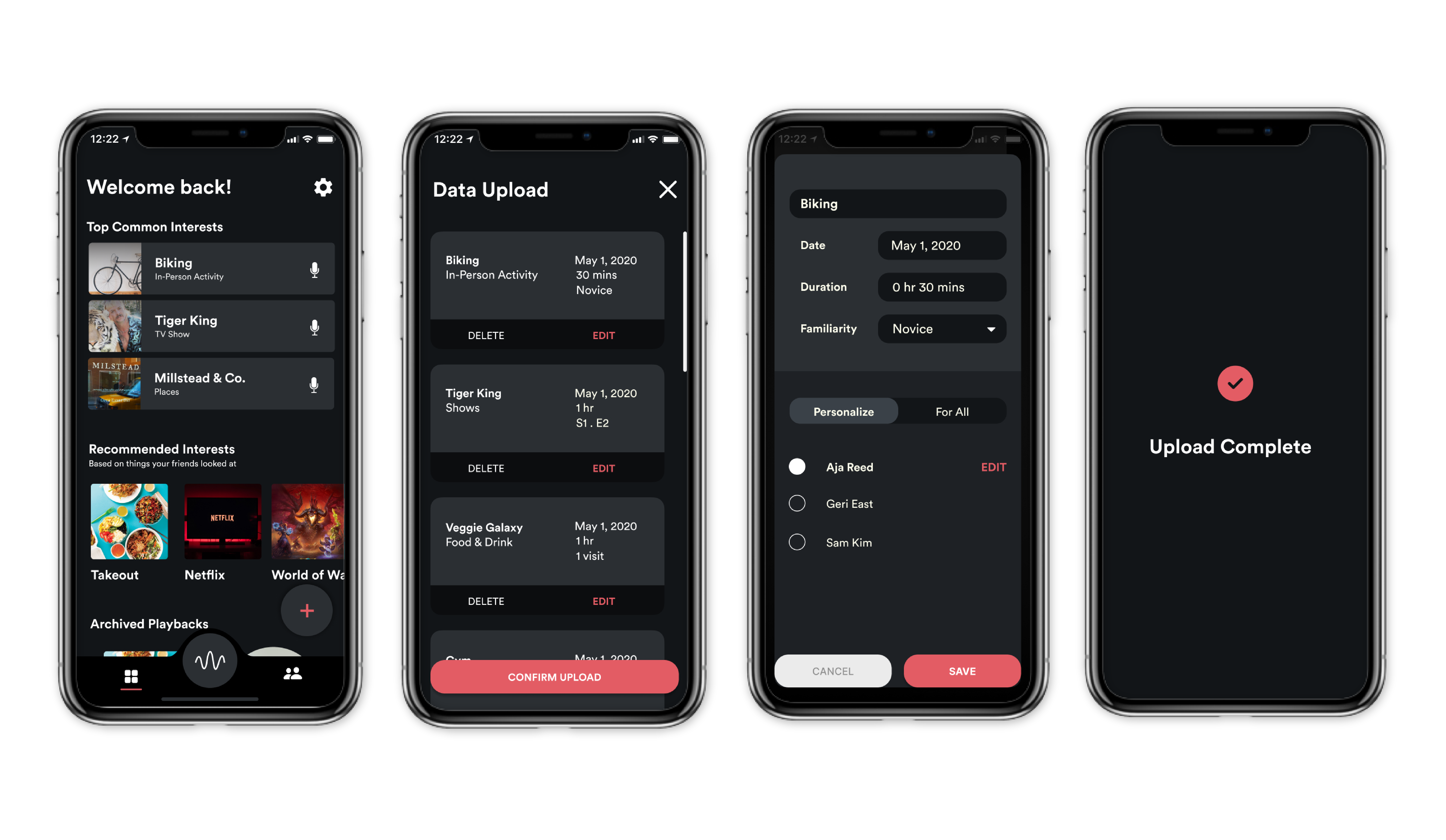Apio Voice
The pandemic has forced us to re-examine how we interact with one another. Unfortunately, that means less time for us to communicate in-person, and more time for us to sit in front of a screen and try to feel the same intimacy we used to.
Over the course of seven weeks, my team and I set out to create a more personalized way to socially interact with one another through the means of one's voice and their data.
TIMELINE
September 2020—April 2021
TEAM MEMBERS
Sandra Yao
Kit Chen
CONTRIBUTIONS
Design Lead
Research Synthesis
Multimodal Prototyping
Visual & Motion Design

PROBLEM
It is difficult to maintain the same levels of personal communication between friends after being separated for a long period of time.

Current social media doesn't seem to be much of a replacement.
It is estimated that the average user would only trust four of their Facebook friends in a life-threatening emergency.
- according to OnePoll, in conjunction with Evite
Although there are so many platforms of virtual communication that attempt to replace in-person interactions, from video calls on Zoom to posting photos on Instagram, what becomes missing is that special touch from someone who cares about you.

Our Response
Apio
Latin - “to fasten the tie, join, and connect”
Apio is a voice-prominent, private form of social media that allows close friends with long-distance contact to keep each other updated on their everyday life, through the data they collect and the comments they receive from them.
Find Your Friends
MOBILE APP
Upon initial setup, you can add contacts that you are looking to stay in touch with on the mobile app, and set up time frames in which you and your long-distance friend can talk.
Record Your Interests
CONVERSATIONAL UI (with Cloud Data)
While Apio automatically collects your own data based on the own preferences you select, you can also manually record and annotate your interests and activities easily with a conversational user interface, anytime and anywhere, throughout your week.
Manage/Upload Your Comments
MOBILE APP
The mobile application acts as a data hub for data collection and managing interests shared with friends (up to four people) through a mobile application. Once the week is over, record your comments on certain topics and upload your interests to be converted into an audio-based summary.
Listen to Your Friend's Updates
PHYSICAL SPEAKER DEVICE
At the end of your week, listen to an audio summary that details common interests and updates from your close circle of friends. Upon conclusion of your summary, you will be prompted to schedule a time and meeting.
My Contributions
While we all worked together on the research, ideation and scenario building phases, I was mainly responsible for facilitating and sketching out the UX and interactions involved for the physical device. I crafted out the user flows, created preliminary sketches, and created the hi-fidelity screens for it (however my partner Kit created the final 3-D model). Upon conclusion of the project, I also made some visual refinements to some of the mobile app.
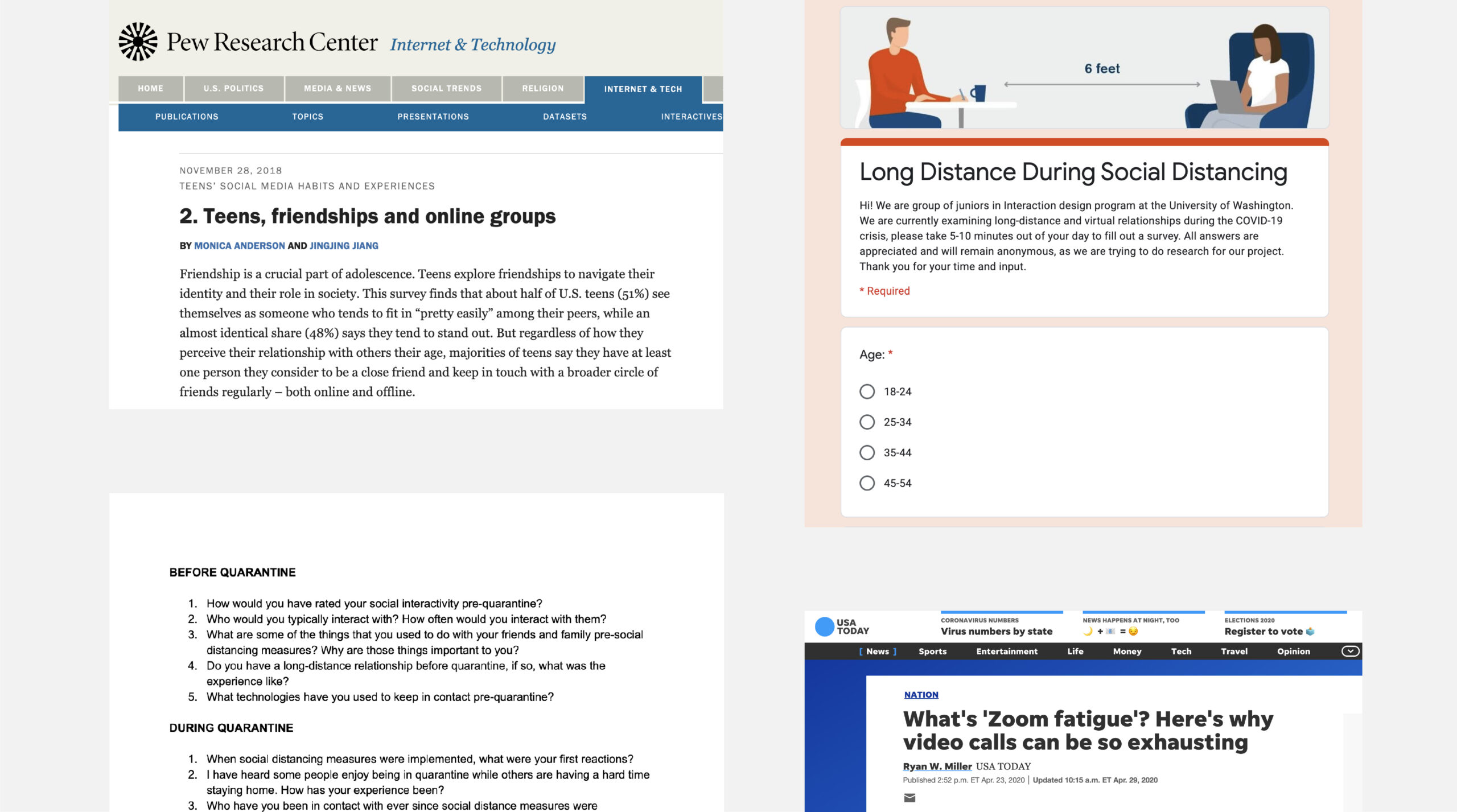
Researching the Space
How are people communicating with each other in the midst of social distancing?
Created in the midst of a pandemic, our project was initially created as part of a question to understand how people were co-operating in the midst of social distancing. During our research, we noticed that trends of long-distance communication have strongly adapted to the transmission of data, with social media playing a large force in facilitating those interactions.
Research Conducted
- Quantitative/Qualitative Survey amongst 18-24 yr olds
- Semi-structured Interviews
- Remote walkthrough of our own home environments
- Secondary studies and supporting research articles
"With texting, it's periodic communication; I don't interact with others first. With Instagram, I see people's updates but I don't get to hear about what's really going on in their lives."
-SURVEY RESPONSE
What We Learned
Although there are methods to express oneself over long distance, it's difficult to feel truly connected with others.
Communicating digitally relieves some social anxiety that with in-contact relationships. However, it is still harder for people to feel sympathy virtually.
Social media isn't a one-size-fits-all replacement to interpersonal communication.
There is no exact alternative to in-person interactions; although social media, texting, Zoom calls, or even Facetime are prominent uses of communication, what becomes missing is that sense of being close with someone you're connected with.
We learn to discover the commonalities between lives and share them through our data.
Some of the best moments that people in long-distance friendships share are in the little habits of their everyday life, such as the media they watch and the activities they’ve done. These commonalities are often shared today through the data we share with each other, as what traditional media has shown.

Translating Insights
We generated over 50 ideas that covered a variety of themes, from Hololens mixed reality shared spaces to abstract data visualizations that could hang in the comfort of a living room. Eventually, it was with the vision of creating a system that allowed the facilitation of data that we narrowed these ideas down to three primary sources of technology that could best suit each of the primary goals that we chose to address.
Principles that Drove Our Vision
SUBTLE
While most traditional forms of media intrude into our lives, we wanted to create a product that was a adaptable to a home environment and be used throughout existing living habits.
COMMUNICATIVE
It should act as a vocal way for two friends who currently live in different environments to improve their communication and identify common threads between their lives.
PERSONALIZED
As communciation trangresses through forms of digital media, we wanted to make sure that the data they were sending each other was personalized to each other.
Based our research, we were able to translate each of these goals into three primary sources of technology that could best address our problem scope.
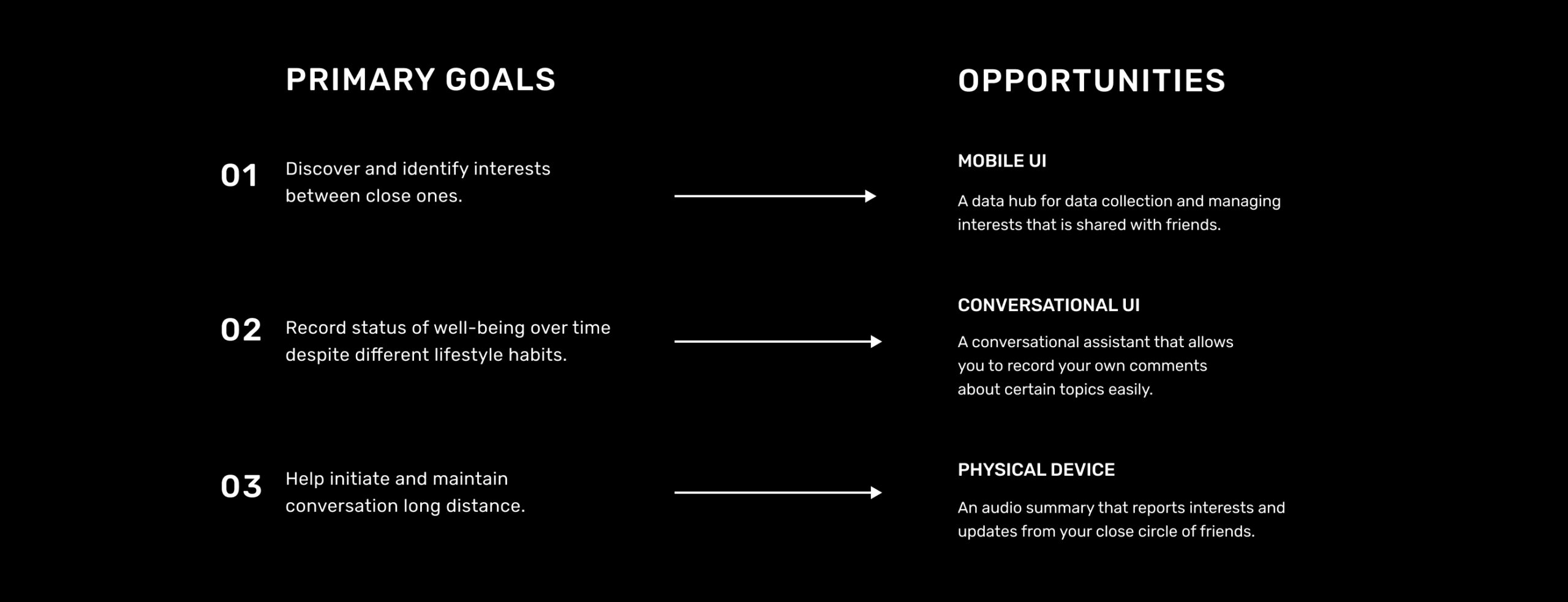
Why are we using voice-based technology?
From our research, although there are methods of social media that assist in this void, nothing can replace interpersonal communication. However, even in the midst of video calls and Facetime, hearing someone else’s voice emerges as a much more reliable second choice, for it allows people to interpret and gain a better sense of a person that is in the room, without feeling too ingenuine.
Scenario Building & Conceptual Modeling
Due to the complexity of our system, we broke down our overall system by developing a two-person scenario to best express our thoughts into how we felt our design response would hypotheically play out. By mapping our story, it helped assess and define a conceptual map to best pinpoint key times in which voice can be intergrated into their everyday lives.


Addressing Data Privacy and Ethics
One decision that we had to address was how data was being collected, and whether or not we chose to use existing data cloud platforms to faciliate this transaction. We realized that creating a system that facilitates personal data requires care, and that enabling trust in any type of technology is key. That said, when developing the system, we took careful considerations to ensure privacy, and wrote out key use cases to lower those risks.

Refining and Prototyping
Designing for 3-D Form
Once we established and finalized the user flows and the intricacies of our system, we each split off and approached our own assignment. Because there were no craft stores open at the time, I used sticky notes and old packaging to prototype and refine the interactions necessary on the device.
Designing with Limited Screen Capabilities
By using this method, I started to uncover why we even needed to have a promiment screen interface; it is a voice-prominent system, right? After further iterations, with the assistance of sketching out potential 3-D forms, I reduced the amount of color on the screen to a mere black-and-white setting, to follow our principle of nuanced form of technology.
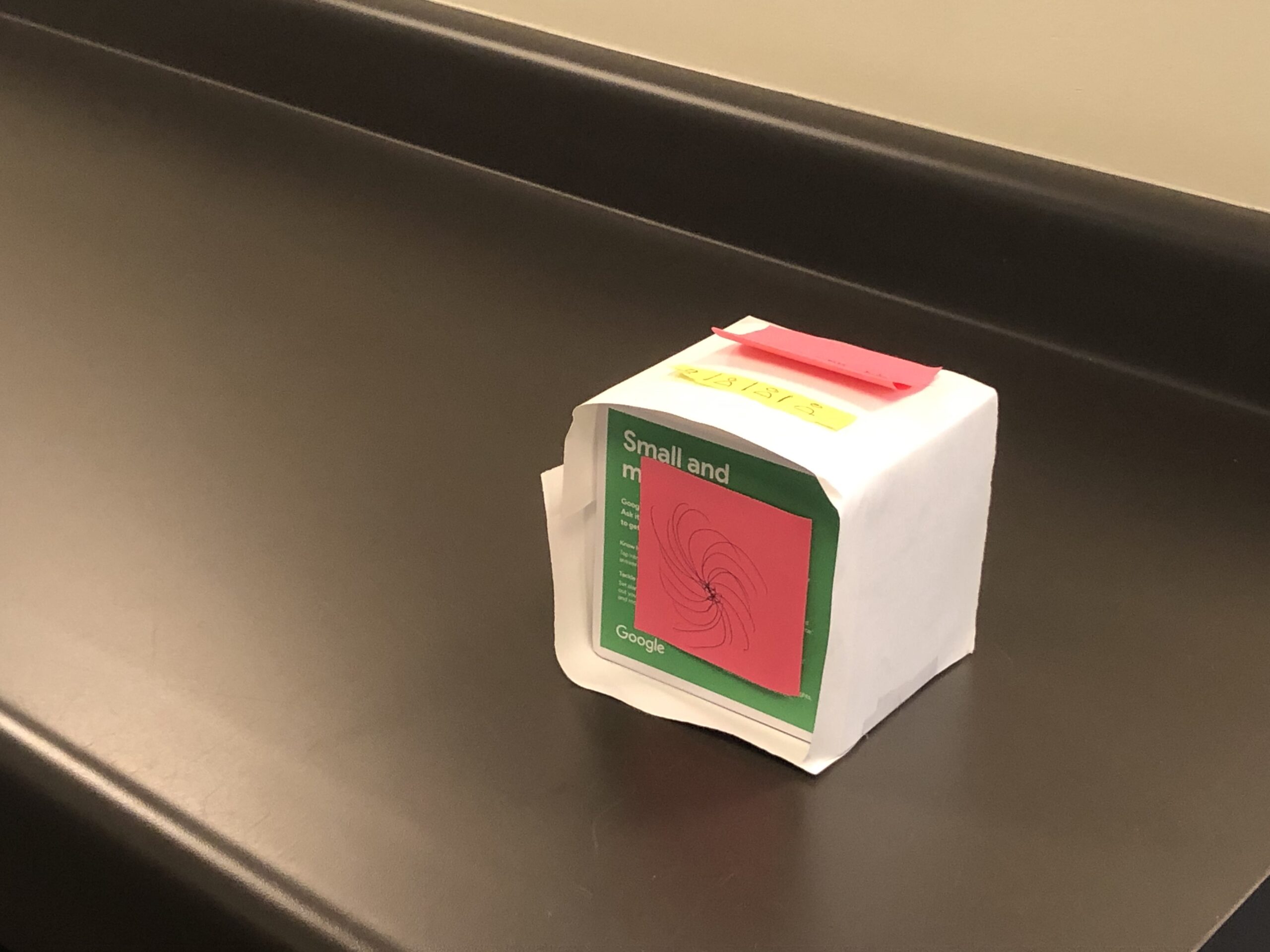
Sample Dialogue
INTRO
“Welcome back, Daniel, this is your WeeklySync from Aja."
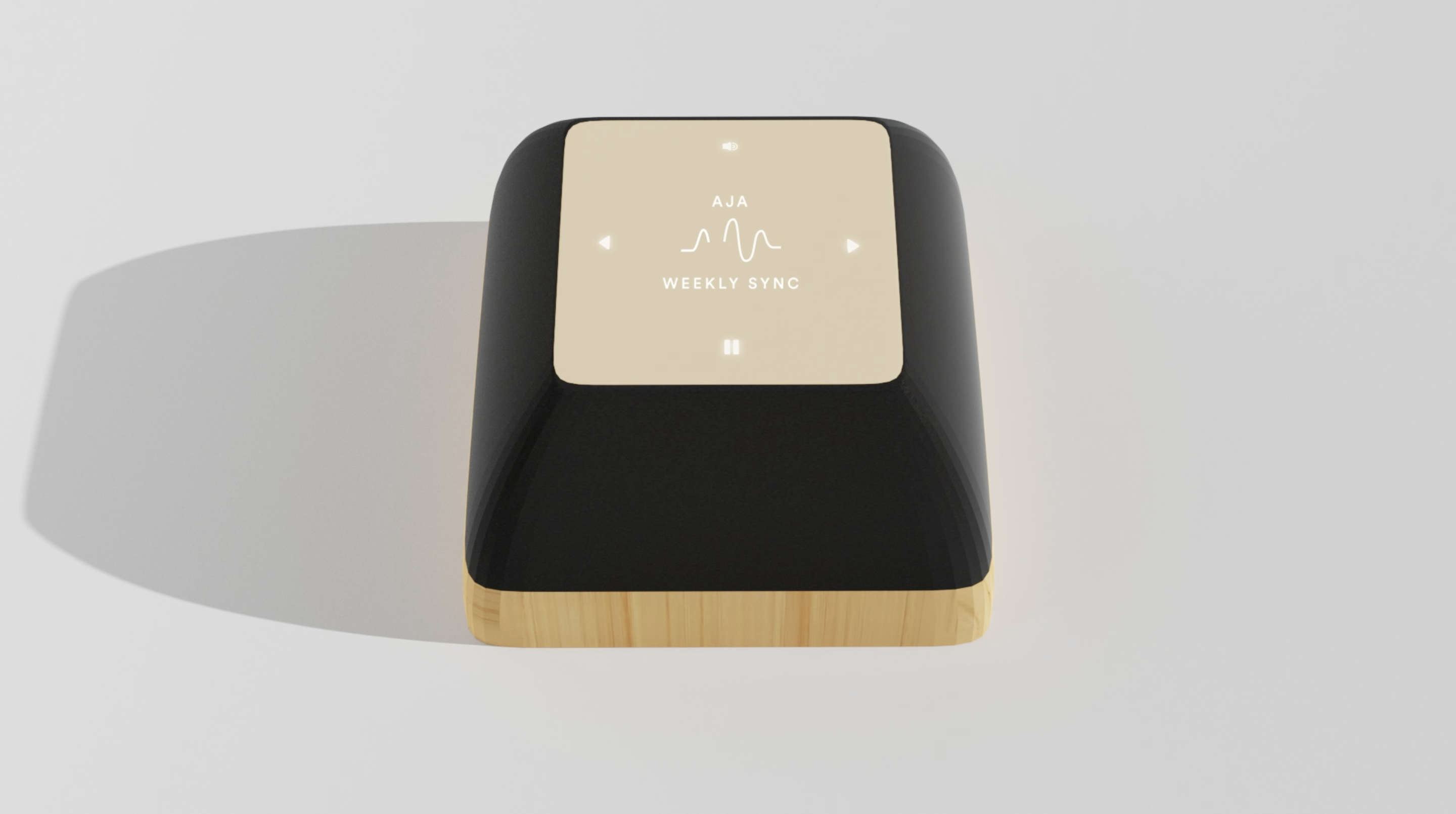
FIRST TOPIC: CORONAVIRUS
"The coronavirus pandemic is pushing America into a mental-health crisis."

CORONAVIRUS COMMENT FROM AJA
"Honestly, this quarantine is stressing me out. I hope you're doing okay."

CONCLUSION COMMENT FROM AJA
"Hey, I know it's been so long since we last talked, but we should catch up this Saturday and have a Zoom night! What times are you available?"

What I Learned
Condense your thoughts and ideas to tell a story.
While it's important to consider every ramification and detail of the thing you're designing, it's even more essential that your presentation of concept makes sense, or you don't get the feedback you need. Over time we learned to structure our presentation format in such a way that others with little knowledge of our project could easily understand us.
User experience is not objective.
In contrast to the way most schools teach UX, when defining a user experience it's good to have a point of view and use research and findings to tailor your scope and your argument to others, not the other way around.
Working remotely means being adaptable.
Although there have many Zoom calls, Mural boards, and Figma files, I will say I will miss working in a studio. However, in a time of remote collaboration, it's safe to say that it's important to try new things, overcome those barriers, and work together to make a product that works.
Next Steps
Like most projects, 6 weeks to drill down a system is simply not enough. If we had more time to work on this project, we would:
- Exploring group dynamics and scenarios in the radio summary
- Get feedback on mobile and the physical form and conduct usability testing
- Conduct extensive interviews and workshops of long-distance relationships in order to better map out touchpoints
- Create a full concept video that can map out our storytelling

